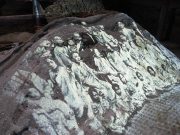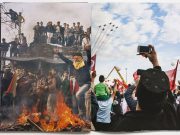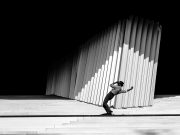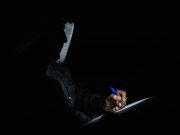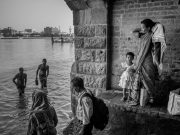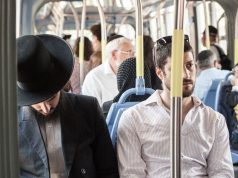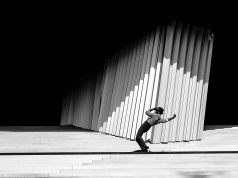Suite au séisme meurtrier qui a frappé le Népal samedi 25 avril, un groupe constitué de photographes locaux a créé le Nepal Photo Project, un compte Instagram, afin d’informer les internautes du monde entier sur la situation concrète des populations touchées par le séisme.
► See the interview in English at the end of the article
OAI13 a interviewé Tara Bedi, l’iconographe qui se charge de choisir les images publiées sur Instagram. Elle nous a raconté l’objectif de ce projet.
OAI13 : Pourquoi avez-vous créé le compte instagram Nepal Photo Project ?
Tara Bedi : On tient déjà un compte appelé India Photo Project qui présente de la jeune photographie contemporaine indienne. En fonction de l’heure, on y diffuse des images en rapport avec des évènements d’actualités ou des causes qui ont besoin de visibilité. On essaye de donner une perspective collaborative à ce projet.
C’est dans cette même intention que le Nepal Photo Project. Le séisme a eu lieu et nous avons senti que c’était le meilleur moment pour publier collectivement du contenu critique, crédible et utile fait par des personnes en qui nous avons confiance sur le terrain, toutes réunies dans le même projet.
Quel est le rôle de ce compte instagram ?
Instagram a environ 300 millions d’utilisateurs. C’est évident que les gens ont tendance à consommer de l’information en priorité par l’image. Le Nepal Photo Project constitue notre moyen de faire en sorte qu’il y ait un maximum d’information de qualité sur internet, aussi tôt que possible.
De l’étendue des dégâts aux conditions dans lesquelles les gens vivent, du travail des secours à ce qu’il se passe ailleurs qu’à Katmandou (puisque nous avons des photographes en dehors de la capitale), des actions d’aide individuelles et collectives aux types de besoins nécessaires sur place, notre équipe tente de couvrir les conséquences de ce séisme de la façon la plus large possible. Nous créons une documentation concrète de la vie après le séisme. Notre volonté est de couvrir de façon pragmatique comment la vie s’organise après cette catastrophe humaine : comment les gens vivent, comment ils mangent, comment ils se procurent de l’eau et du matériel médical.
On a aussi créé une page Facebook où l’on relaye les campagne de dons pour les organismes qui semblent faire du bon travail (ceux dont nous pouvons attester du travail et de l’engagement).
Qui sont les photographes contributeurs ?
Nous sommes un groupe de photographes basés au Népal et en Inde. Ensuite, nous parcourons Instagram avec certains hashtag comme #nepal ou #nepalearthquake pour voir ce que les internautes publient. Quand on voit des images intéressantes, contacte les auteurs pour leur demander l’autorisation de publier leurs images. On a aussi créé le hashtag #nepalphotoproject pour ceux qui veulent proposer leurs images. Certaines de nos publications les plus pertinentes viennent de ce prisme.
Nos photographes contributeurs sont :
Bhushan Shilpakar (@bhushanshilpakar)
Nayanatara Gurung Kakshapari (@ntgk)
Saagar Chhetri (@saagarchhetri)
Sumit Dayal (@sumitdayal)
Chandan Khanna (@khannachandan)
Kishor Sharma (@kishorksg)
Prashanth Vishwanathan (@prashanthvishwanathan)
Sujatro Ghosh (@sujatroghosh)
Theodore Sam (@insidemyviewfinder)
@bimlabai (dont je ne connais pas le nom mais qui a émergé durant nos recherches)
Marcel Fahle (@marcelfahle qui vient également de nos recherches)
Il y en a quelques autres mais ils ne sont pas encore publiés car ils n’ont pas de connexion internet pour envoyer leurs images.
Quelles images décidez-vous de publier ?
Le critère principal dans la publication d’une image c’est son contenu et l’information qu’elle donne. Nous faisons attention à ce que nos légendes soient approfondies pour que l’image devienne utile. Nous avons bien sûr montré des images de destruction pour montrer l’étendue des dégâts, mais on souhaite se concentrer sur la condition dans lesquelles les gens vivent et quelles sont les mesures qui peuvent les aider. Ce serait bien de voir des images du travail des secours des grosses organisations. Pour le moment, à part deux ou trois images, nous avons seulement réussir à montrer les actions civiles d’aides.
Avez-vous eu des retours sur votre travail ?
Pour le moment ils sont plutôt bons. Beaucoup d’internautes sont contents de pouvoir accéder à cette information quasi brutes, sans l’éditorialisation de magazines ou de quotidiens. Nous avons eu une question sur la véritable utilité de nos images. Notre réponse à cela c’est que nous montrons la situation telle qu’elle est, même si elle est faite de paquet de noodles, de réchauds de fortune et de bâches en guise de maison. La réalité de la situation aujourd’hui, c’est que les gens ont peur de retourner chez eux car ils ont peur que leur maison ne s’effondre dans une réplique du séisme.
Pourquoi est-ce important de publier ces images sur un réseau social web et pas seulement dans les quotidiens et les magazines ?
Internet a une portée plus grande et globale. Un grand pourcentage de la population ici est soit sur internet, soit utilise son smartphone. C’est plus facile, rapide et moins onéreux de publier du contenu sur internet, surtout dans un moment de crise comme celui-ci où nous avons besoin d’informations immédiates. On peut s’appuyer sur la presse pour envoyer des informations au reste du monde demain ou après demain. Mais si on peut parler à ce reste du monde instantanément, et que ce reste du monde peut aider instantanément, alors pourquoi ne pas le faire ?
Pour faire un don, vous pouvez vous référer à la page Facebook du Nepal Photo Project qui recense les associations et organisations actives sur place.
Facebook : facebook.com/nepalphotoproject
Instagram : instagram.com/nepalphotoproject
Voir aussi : Séisme au Népal : s’informer par l’image sur les réseaux sociaux
The interview in English :
Why did you create the instagram account Nepal Photo Project?
We run a feed called India Photo Project that showcases fresh and contemporary photography out of India – depending on the need of the hour, we switch focus to major current events or causes that need attention and try to give a collaborative perspective on it.
It was with the same intention that Nepal Photo Project was born. The earthquake hit and we thought this is the best way to collectively put out critical, credible and useful information from people that we know and trust on the ground, all under one banner.
What is the role of this instagram account ?
Instagram has approximately 300 million subscribers – it is evident that people tend to consume news and information primarily through images. Nepal Photo Project is our way of trying to make sure we get as much real information out there, as soon as possible.
From the extent of damage, to the conditions people are living in, to rescue and relief efforts, the scenario in various parts of the city (since we haven’t been able to venture out of Kathmandu), individual and collective volunteer efforts being set up, the kind of resources that are actually needed, etc – our team is covering as much as they can.
We also have a corresponding Facebook page where we post links to relief/donation campaigns that seem to be doing good work, usually these are ones we can personally vouch for. The link is facebook.com/nepalphotoproject
Who are the photographers contributing ?
We have a bunch of photographers – both from Nepal and India covering various aspects of the earthquake (mentioned above). We are diligently scanning through certain hashtags (like #nepal and #nepalearthquake) to see what other people are posting. We are also asking our followers to hashtag their images with #nepalphotoproject. If we see some useful and informative posts, we ask for some additional information and then we request those Instagrammers to let us feature their images. Some of our more insightful posts have come out of this pool.
Contributing photographers so far are —
Bhushan Shilpakar (@bhushanshilpakar)
Nayanatara Gurung Kakshapari (@ntgk)
Saagar Chhetri (@saagarchhetri)
Sumit Dayal (@sumitdayal)
Chandan Khanna (@khannachandan)
Kishor Sharma (@kishorksg)
Prashanth Vishwanathan (@prashanthvishwanathan)
Sujatro Ghosh (@sujatroghosh)
Theodore Sam (@insidemyviewfinder)
@bimlabai (whose name I don’t know but came out of our hashtag pool)
Marcel Fahle (@marcelfahle who also came out of our hashtag pool)
There are a few more, but we’re still waiting on them to get to a place with internet.
What images do you decide to publish ? Why ?
We decide to post images primarily based on content and the information they’re giving. We make sure our captions are as thorough as they can be so the image becomes useful. While we did show some of the damage and devastation, we want to focus more on the condition people are in and what measures are or can be taken to help them. It would be great to see some images showing all the rescue/relief work that the various big guns are doing. Barring a couple of posts, we have only managed to cover civilian activity.
Do you have some feedback already on your work ?
It’s been mostly good. A lot of people are happy to get access to this level of information rather than more editorialised content. We have also had a complaint about how useful some of our images are, to which we’ve responded that the intention is to give as much REAL information, even if it shows a migrant worker cooking his packaged noodles on a makeshift stove under the tarp that’s giving him shelter. That is the reality of the situation in Kathmandu right now. People seem to be too scared to go back into their homes out of the fear that they might collapse on them.
Why is it important to publish photos on the internet and not only in newspapers and magazines ?
The internet has a much larger global reach. A huge percentage of our population is either online or using a smartphone. It is easier, faster cheaper to push out and circulate content via the internet, especially in moments of crisis like this that need immediate response. We can rely on today’s news to get to the world tomorrow, but when we can reach them this instant, and they can help immediately, then why not?

